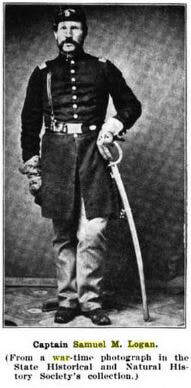Samuel M. Logan: Man of Action
 Samuel M. Logan isn’t a name that many would recognize as a Civil War personality, but he played an important supporting role in the Colorado Volunteers and has a small role in my novel Glorieta, the second of three books in Rebels Along the Rio Grande.
Samuel M. Logan isn’t a name that many would recognize as a Civil War personality, but he played an important supporting role in the Colorado Volunteers and has a small role in my novel Glorieta, the second of three books in Rebels Along the Rio Grande.Samuel M. Logan was a Mexican American War veteran who was working as a blacksmith in Denver when the Civil War broke out. He didn’t waste any time in showing on which side his sympathies lay with a grand gesture.
On April 24, 1861, just days after the bombardment of Fort Sumter, the southern sympathizers who owned Wallingford and Murphey’s Mercantile on Larimer Street in downtown Denver raised the Confederate stars and bars on the pole atop their building. The flag attracted an angry mob of pro-Union sympathizers who threw rocks at the store and demanded that the flag come down.
This is when Logan swang – literally - into action. He climbed a hitching rail and swung himself onto the roof of the store. Accounts of what happened next contradict each other. Some accounts say that the Marshal showed up at this point, dispersed the crowd, and allowed Wallingford and Murphey to continue flying the Confederate colors. Other accounts say that Logan pulled down the flag and ripped it to shreds as the crowd cheered him on.
Whichever is the case, Logan’s stunt made him popular enough that he was able to recruit a company of men to follow him into the volunteer army that William Gilpin, the newly appointed governor of the territory, was raising. In those days, whoever brought in the required number of men was given the commission to lead them. Samuel M. Logan, blacksmith and climber of roofs became Captain Samuel M. Logan of Company B of the Colorado Volunteers.
Logan’s reputation for quick and dramatic action led him to receive some orders that made for exciting press releases. In late August, his Company was ordered to clean out the Criterion, a saloon that was a notorious gathering place for secessionists. Logan and his men stormed in with bayonets fixed. They confiscated a large pile of weapons and ammunition and became the darling heroes of Denver.
However, the same qualities that made him a man of action didn’t make him a beloved leader. By September, Company B had delivered a petition to Governor Gilpin requesting that he remove Captain Logan, “whose overbearance and tyranny have become untolerable.” The Governor chose to ignore this petition.
Logan’s Company engaged the enemy on both days of the Battle of Glorieta. On the second day, it was part of the group that Major John Chivington led over the top of Glorieta Mesa in what was intended to be a flanking movement to attack the Confederate force in the rear. Instead, they overshot and instead of fighting in the Battle of Pigeon’s Ranch, descended from the mesa at Johnson’s Ranch, where they were able to destroy the Confederate baggage train, effectively destroying the Confederate Army’s ability to wage war in New Mexico.
From then on, Logan’s rise through the military was tied to that of John Chivington’s because the two were men of fiery and decisive action who held a “take no quarter” attitude, especially when it came to treatment of American Natives. By spring of 1864, Logan had been promoted to Lieutenant Colonel, bypassing other officers who argued for more leniency in dealings with the Plains Tribes. With Chivington, Logan participated in the infamous Sand Creek Massacre in November 1864.
 Jennifer Bohnhoff is a writer and educator who lives in New Mexico. Her second book in Rebels Along the Rio Grande, a trilogy of novels about the Civil War in New Mexico, will come out this spring.
Jennifer Bohnhoff is a writer and educator who lives in New Mexico. Her second book in Rebels Along the Rio Grande, a trilogy of novels about the Civil War in New Mexico, will come out this spring.
Published on January 21, 2020 00:00
No comments have been added yet.



